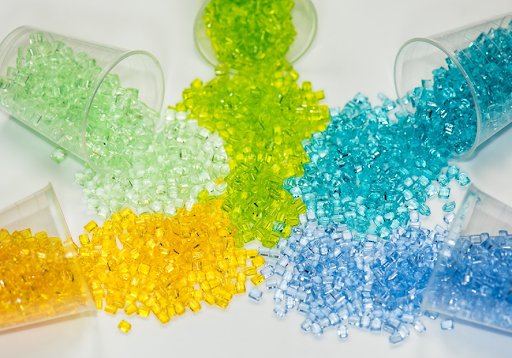
PPC plastic has an ability to be completely recyclable and degradable
Thermoplastic Polypropylene Carbonate (PPC plastic) is no stranger to the applications of non-woven fabrics, agricultural wrapping films, medical wrapping films, etc. PPC plastic stands out among plastic materials thanks to its ability to be completely recyclable and degradable. It can be considered that the complete decomposition of PPC plastic makes them one of the leading materials in terms of environmental friendliness. Timely updated information about the mechanical properties, chemical properties, formation and decomposition process of PPC plastic will help manufacturers make decisions about the most optimal production plan. All this useful information will be revealed below.
1. What is Polypropylene Carbonate?
1.1 Definition of Polypropylene Carbonate
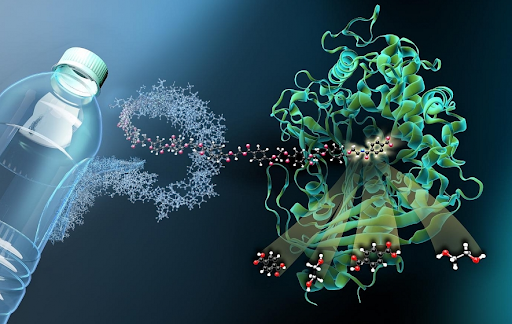
Polypropylene Carbonate is one of the thermoplastic materials
Polypropylene Carbonate is one of the thermoplastic materials and also known by the abbreviation PPC plastic. This is a polymer material belonging to the carbon sequestration group. The outstanding potential of PPC plastic is its ability to completely decompose. They are soluble in dichloromethane, chlorinated hydrocarbons, lower ketones and ethyl acetate. Some solvents that cannot dissolve PPC resin include alcohol, water and aliphatic hydrocarbons. This is an amorphous adhesive with a glass temperature between 25 degrees Celsius and 45 degrees Celsius. Under different catalytic conditions, the performance of Polypropylene Carbonate will also be different. This is one of the very important notes in the PPC plastic production process to suit business needs and optimize costs.
In 1969, the copolymerization of epoxide and CO2 (catalyzed by diethylzinc and water) created the material Polypropylene Carbonate. Since then, PPC has been widely interested and researched by many experts around the world.
1.2 Structure of PPC plastic
Polypropylene Carbonate (PPC plastic) created from CO2 and PO carries quite strong barrier properties. The chemical structure of PPC plastic contains an ether bond (-O-) on the main chain axis. This quite special bond helps PPC plastic increase its flexibility and solubility in organic solvents. We can analyze the characteristics of the link chains in PPC plastic as follows:
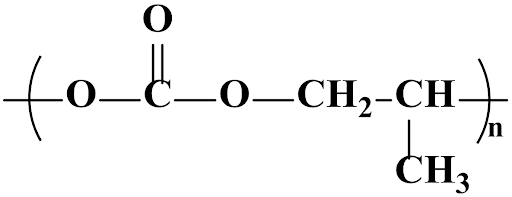
PPC plastic created from CO2 and PO carries quite strong barrier properties
- Ether (-O-): thanks to the ether bond, the molecular chain can be separated easily.
- Polar carbonyl (-CO-): intermolecular forces and molecular stiffness in PPC plastic are perfectly enhanced thanks to this bond group.
- Ester (-COO-): is the factor that makes PPC plastic easily hydrolyzed in a certain time.
- Hydroxyl (-OH): this is the group of factors that determine the thermal stability of PPC plastic. Under high temperature conditions, alcohol decomposes lipids, leading to decompression type degeneration. This can confirm that they cannot withstand high temperatures
- Methyl (-CH3): affects the properties of PPC plastic. In case this bond group is larger, the molecule will be harder and the resistivity will be higher.
2. Properties of Polypropylene Carbonate (PPC plastic)
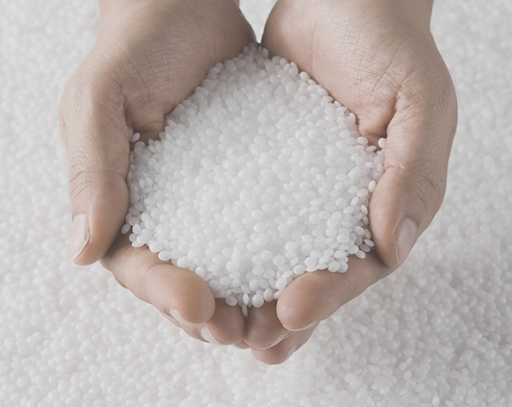
PPC plastic plays a role in reducing plastic waste and the greenhouse effect.
2.1 Mechanical properties of PPC plastic
To comprehensively evaluate a certain material that cannot ignore its mechanical properties such as tensile strength, elongation, breaking strength, elastic modulus and melting strength, etc. With no exception for PPC plastic, it has been researched and proven that PPC plastic has an Tg about 40.3 ° C. When the temperature increases from below Tg to the glass transition zone, the tissue phenomenon will occur. The energy storage module is reduced from 1000 MPa to 10 MPa. Additionally, the modulus of PPC plastic can increase at both temperatures above and below Tg when the average molecular weight of PPC increases from 109 kg/mol to 227 kg/mol.
In general, the mechanical properties of PPC plastic lead to poor thermal properties along with amorphousness and low molecular bonding force, so the mechanical properties of PPC plastic are not very strong.
2.2 Recyclability of PPC plastic
The strong advantage of PPC plastic is its recyclable nature. PPC plastic is a polymer that can be recycled and decomposed within a certain period of time. Raw materials for PPC plastic production are CO2 and PO. When destroyed, PPC plastic will return to CO2 (and small amounts of other non-toxic substances). This process can be understood as not releasing new CO2 into the environment throughout the life cycle from production to recycling of PPC plastic. Notably, the carbon sequestration ability of PPC plastic is a special advantage that helps this material be flexibly recycled in many different applications.
In general, production materials such as CO2 and PO are not too expensive, so they help manufacturers optimize investment costs in production. The process of recycling and decomposing PPC plastic brings great benefits to our environment. Thanks to its flexible recycling ability, PPC plastic plays a role in reducing plastic waste worldwide and partly reducing the greenhouse effect.
2.3 Decomposition of PPC

Microorganisms will directly corrode the surface of PPC plastic
One of the most interesting characteristics about PPC plastic materials is that they can be completely decomposed after being discharged. In fact, there are many ways to decompose PPC plastic, including:
- Thermal decomposition: Because PPC plastic degrades thermally quite strongly, this also affects the quality of the product during heat exposure. However, using heat is one of the popular ways to decompose PPC plastic waste. In the temperature range from 180 degrees Celsius to 240 degrees Celsius, PPC plastic will begin to decompose. Although this method is quite quick, it will produce exhaust gasses during the heating process.
- Biodegradation: this is one of the decomposition processes considered not to pollute the surrounding environment. When PPC plastic waste is placed in the ground, it comes into contact with many species of organisms and plants that can quickly decompose the material. Microorganisms will directly corrode the surface of PPC plastic, leading to broken bond chains and complete decomposition.
- Hydrolytic decomposition: like biological decomposition, this is one of the most optimal processes and limits pollution to the environment during the decomposition stage. The hydrolytic decomposition process will dissolve and break the bonds in the structure of PPC plastic and cause them to gradually age in a solvent environment.
2.4 Material combination
As mentioned above, heat resistance and mechanical properties are quite poor and easily corroded, so these are the shortcomings that make the position of PPC plastic quite limited in the manufacturing industry. To solve this problem, people improve PPC plastic by combining it with other materials to enhance the properties of this material. The meaning of this is to make the most of the recycling potential of PPC plastic while still maintaining its durability for user needs. The process is usually molten mixing or mixing solutions of ingredients together. In particular, melt mixing is applied more than solution mixing because it is quite sophisticated and complicated. However, both of these methods of mixing materials help PPC plastic significantly improve its properties. Materials commonly used to combine with PPC plastic include organic polymers, inorganic polymers, etc.
Read more: PP conductive compound
Read more: PC flame retardant compound
3. Application of Polypropylene Carbonate (PPC plastic)
PPC plastic is still one of the best green materials for the environment thanks to its non-toxic, easy to decompose, easy to recycle and good biocompatibility properties. Through the process of enhancing properties, PPC plastic is widely used in a number of applications as follows:
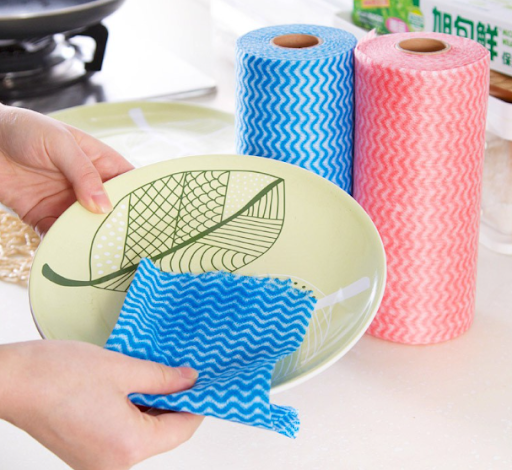
PPC plastic is often applied in non-woven fabric production processes
- Textile technology: PPC plastic is often applied in non-woven fabric production processes used in masks, napkins, handkerchiefs, etc. Non-woven fabrics made from PPC plastic are environmentally friendly and easily decompose after use (most are disposable products).
- Packaging materials: thanks to the non-toxic nature of PPC plastic combined with antibacterial materials such as nanoparticles, organic acids and polymers, one can easily create extremely safe packaging materials for consumer health. Some food packaging and medical equipment are made of PPC plastic to help meet the needs of mass production but optimize costs.
- Production of protective films: protective films made from PPC plastic are often used in agriculture. Thanks to its ability to easily decompose, permeate air and water vapor, some farms use PPC plastic film to protect mushrooms and their color.
- Medical bandages: prepared using electrostatic spinning technology, people produce PPC synthetic fiber membranes used for medical bandages. Tests show that medical bandages made from PPC plastic meet safety conditions for human health and inhibit bacteria up to 69.3%.
4. About EuroPlas’ polypropylene and polycarbonate products
In conclusion, PPC plastic is one of the material lines with great potential in contributing to reducing the amount of waste released into the environment. Although the mechanical properties of PPC plastic are not very advantageous, they can easily be enhanced based on the ability to mix with other materials. This is one of the materials with a reasonable price and optimal investment cost that will be a worthy choice for manufacturers. Find out more useful articles at our EuroPlas blog today! We are committed to being an updated and reliable source of information for your project.